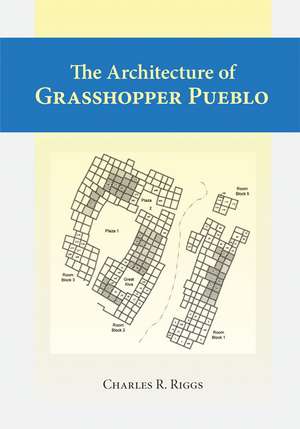Architecture Of Grasshopper Pueblo, The
Autor Charles Riggsen Limba Engleză Paperback – 11 apr 2011 – vârsta până la 80 ani
The long history of field research at Grasshopper, a massive, 500-room pueblo in an isolated mountain meadow in east-central Arizona, has produced a wealth of architectural information. Drawing on this extensive research, Charles Riggs reconstructs the pueblo, and provides a glimpse into the everyday life of the community at a critical time in Southwest prehistory.
Between AD 1300 and 1330, a group consisting mainly of newcomers to the area established and then enlarged Grasshopper. From the architectural remnants excavated by the University of Arizona Archaeological Field School it is possible to determine that the earliest arrivals settled Grasshopper relatively quickly and that subsequent groups from the region and the Colorado Plateau built their houses next to kinsmen. The houses of locals and immigrants remained separate in discrete room blocks despite their occupants’ participation in communal groups.
Ultimately short-lived, by AD 1330 the influx of immigrants tapered and the architecture came to reflect a more seasonal, less intensive use of the area. Eventually the community was abandoned and the walls were left to crumble. In The Architecture of Grasshopper Pueblo, Riggs gives us a new view of community life at this ancient Puebloan site.
Between AD 1300 and 1330, a group consisting mainly of newcomers to the area established and then enlarged Grasshopper. From the architectural remnants excavated by the University of Arizona Archaeological Field School it is possible to determine that the earliest arrivals settled Grasshopper relatively quickly and that subsequent groups from the region and the Colorado Plateau built their houses next to kinsmen. The houses of locals and immigrants remained separate in discrete room blocks despite their occupants’ participation in communal groups.
Ultimately short-lived, by AD 1330 the influx of immigrants tapered and the architecture came to reflect a more seasonal, less intensive use of the area. Eventually the community was abandoned and the walls were left to crumble. In The Architecture of Grasshopper Pueblo, Riggs gives us a new view of community life at this ancient Puebloan site.
Preț: 187.76 lei
Preț vechi: 233.58 lei
-20% Nou
Puncte Express: 282
Preț estimativ în valută:
35.93€ • 36.80$ • 29.89£
35.93€ • 36.80$ • 29.89£
Carte indisponibilă temporar
Doresc să fiu notificat când acest titlu va fi disponibil:
Se trimite...
Preluare comenzi: 021 569.72.76
Specificații
ISBN-13: 9780874808575
ISBN-10: 087480857X
Pagini: 280
Ilustrații: 82 tables, 55 illus.
Dimensiuni: 178 x 254 x 18 mm
Greutate: 0.48 kg
Ediția:1st Edition
Editura: University of Utah Press
Colecția University of Utah Press
ISBN-10: 087480857X
Pagini: 280
Ilustrații: 82 tables, 55 illus.
Dimensiuni: 178 x 254 x 18 mm
Greutate: 0.48 kg
Ediția:1st Edition
Editura: University of Utah Press
Colecția University of Utah Press
Recenzii
“Both readable and dynamically supported with high-quality visual and analytical content, Riggs’s book stands out among architectural studies of its kind.”—American Antiquity
“Particularly well researched. A significant contribution to Southwestern archaeology and in particular to the architectural study of Grasshopper Pueblo.”—Journal of Anthropological Research
"Contains a wealth of information that will be of great value to scholars interested in architecture both in the Southwest and elsewhere."—Ruth Van Dyke, California State University-Fullerton
Notă biografică
Charles R. Riggs is associate professor of anthropology at Fort Lewis College, Colorado.
Cuprins
Contents:
List of Figures
List of Tables
Acknowledgments
1. Archaeology and Architecture
2. Grasshopper Region and Research Overview
3. Architectural Description and Analysis
4. Pueblo Growth and Intrasite Chronology
5. Architecture and Grasshopper Society
6. Summary and Conclustions
Appendix: Architectural Data Tables
Notes
References
Index
List of Figures
List of Tables
Acknowledgments
1. Archaeology and Architecture
2. Grasshopper Region and Research Overview
3. Architectural Description and Analysis
4. Pueblo Growth and Intrasite Chronology
5. Architecture and Grasshopper Society
6. Summary and Conclustions
Appendix: Architectural Data Tables
Notes
References
Index
Descriere
Drawing on extensive research, Charles Riggs reconstructs the Grasshopper pueblo—found in an isolated mountain meadow in east-central Arizona—and provides a glimpse into the everyday life of the community at a critical time in Southwest prehistory.
